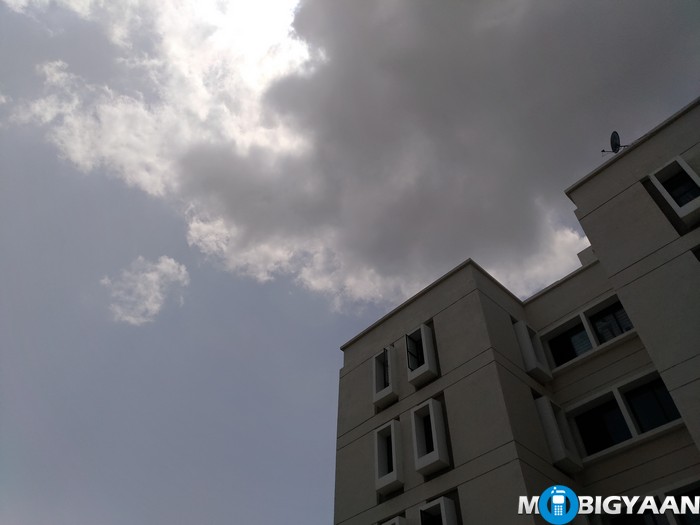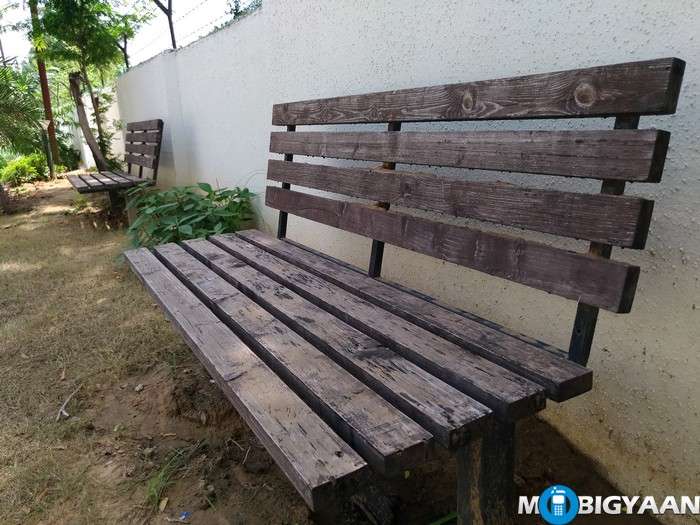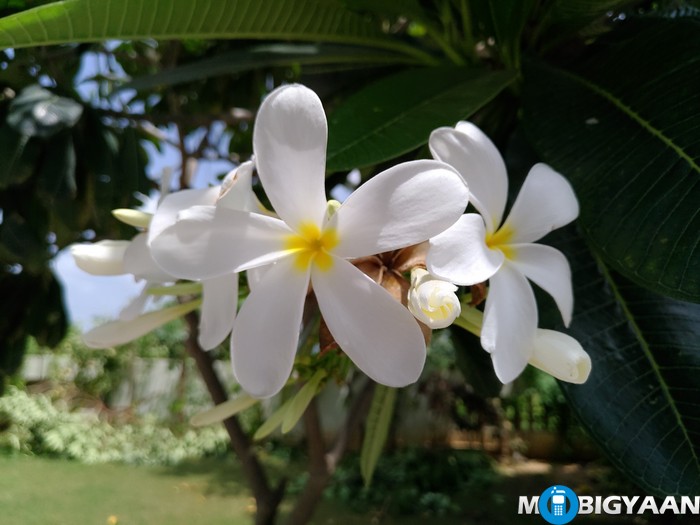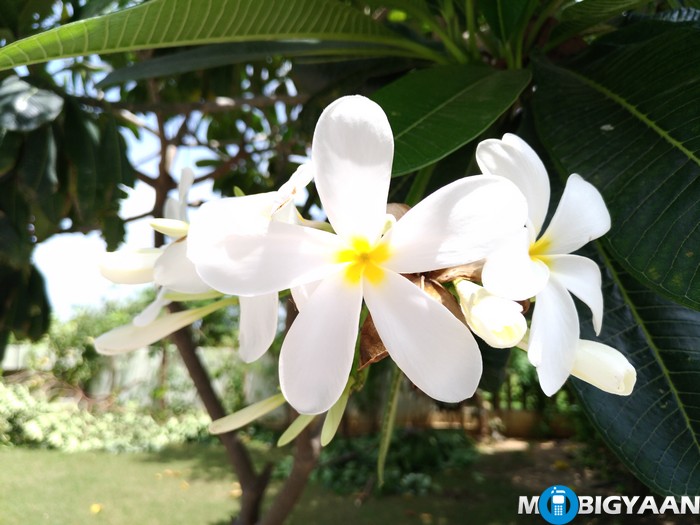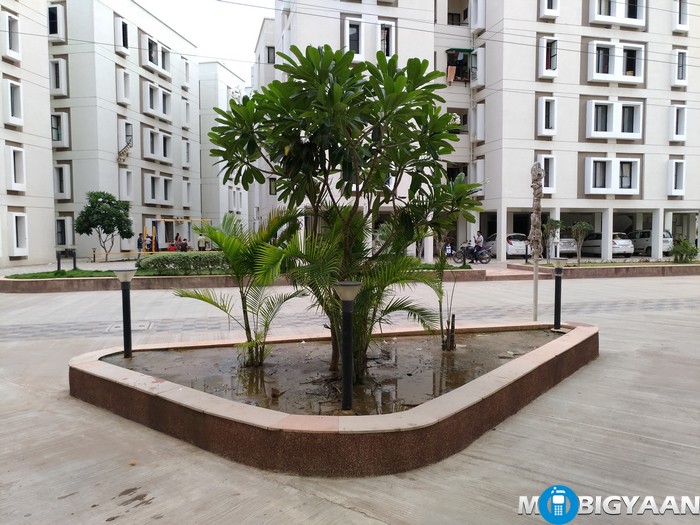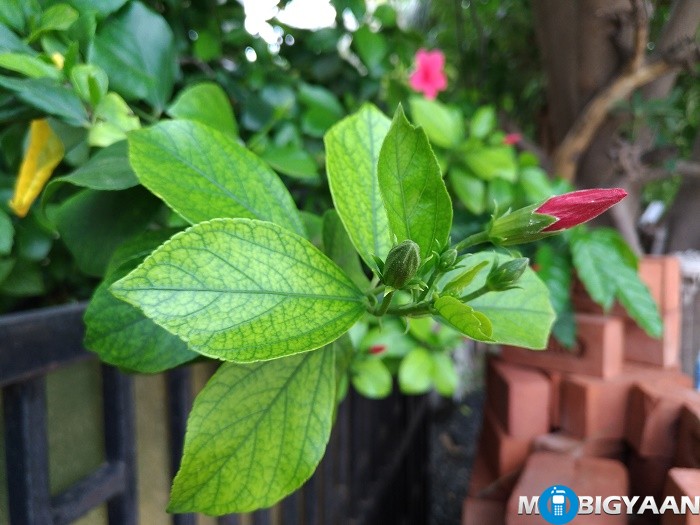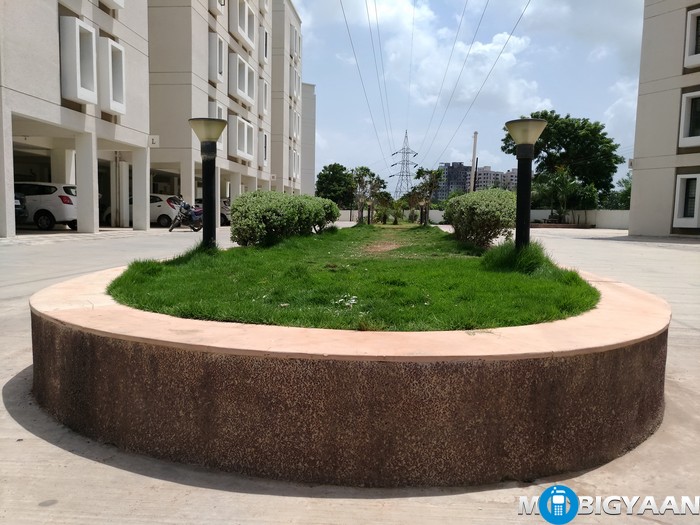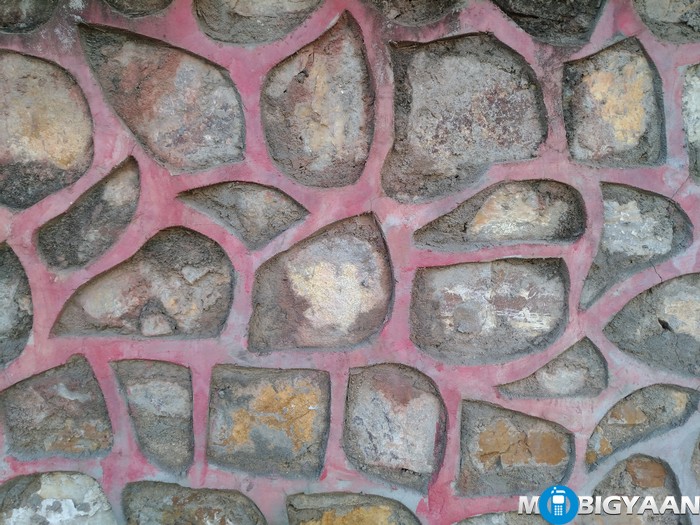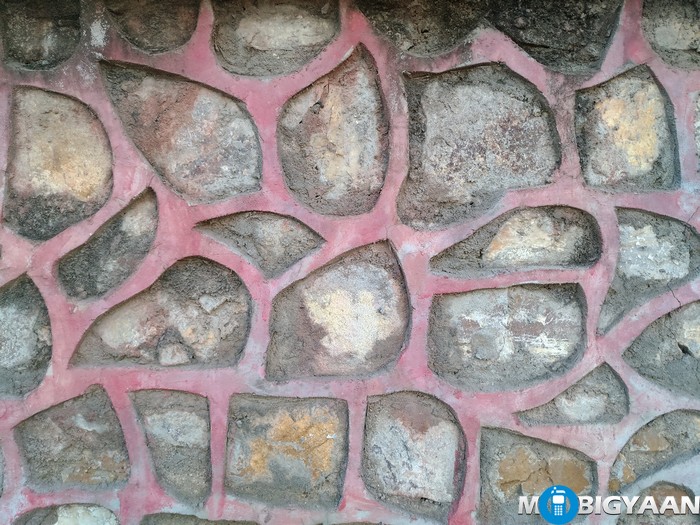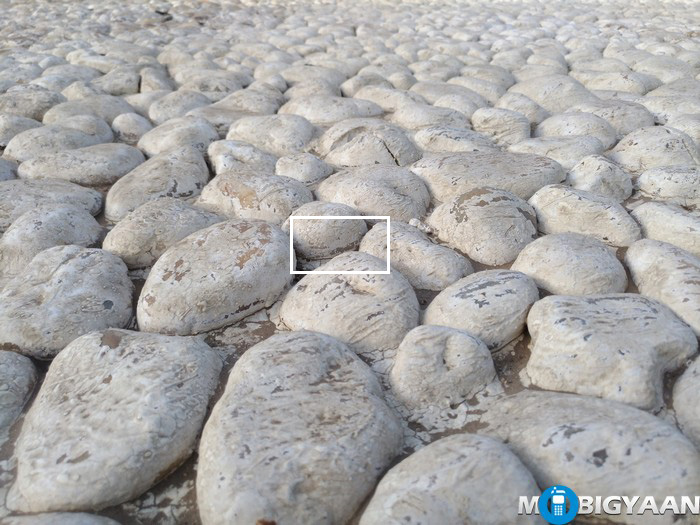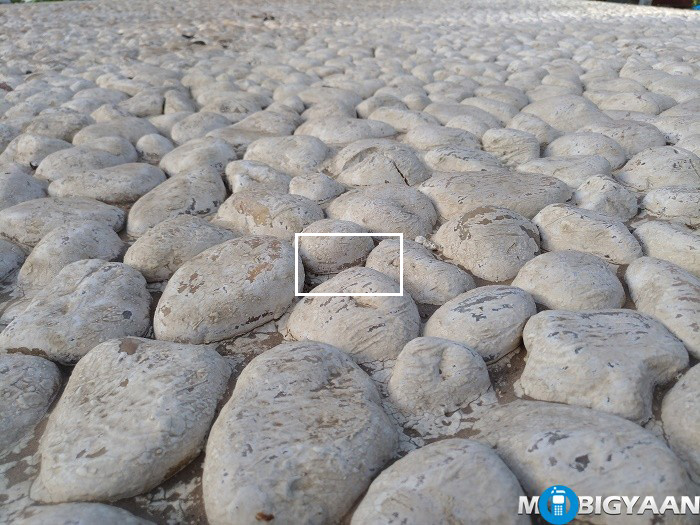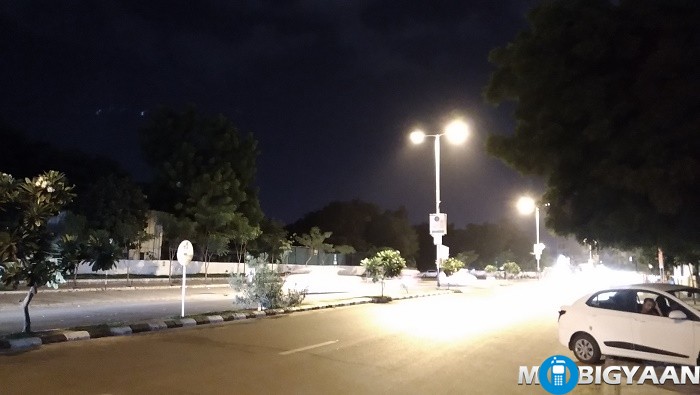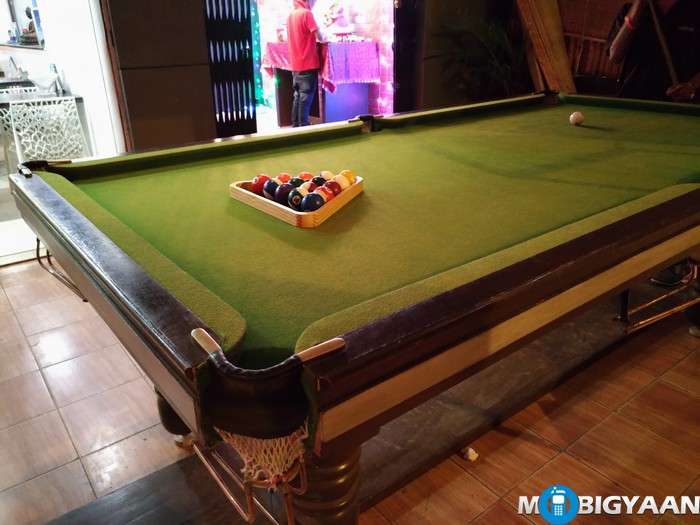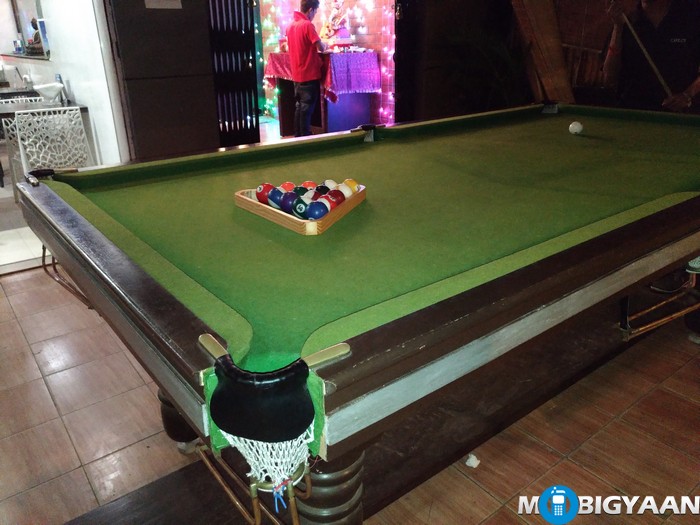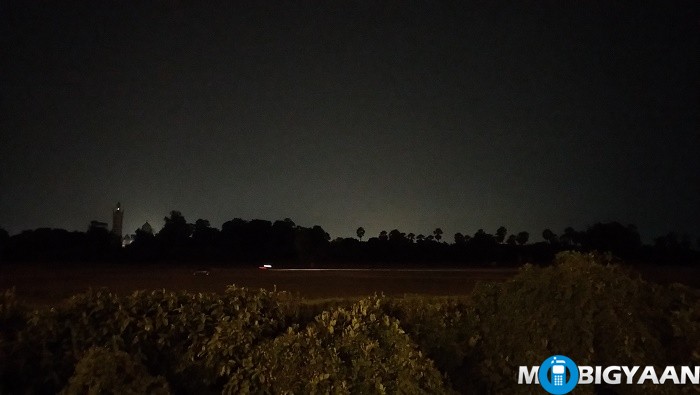ASUS launched multiple variants of ZenFones 3 in India. we have the ASUS ZenFone 3 (ZE520KL) – the cheapest among all the other ZenFone 3 variants. Last year’s ZenFone 2 was the first smartphone to feature a 4 GB RAM that was priced at ₹18,999 boasting a flagship Intel-based processor. While the scenario is a tad different in the ASUS ZenFone 3, it is priced higher (₹21,999) than its predecessor (₹18,999) despite using a mid-range Snapdragon 625 CPU. It’s an entry-level smartphone from the ZenFone 3 family highlighting a 2.5D curved glass design. After using for about 10 days, our ASUS ZenFone 3 review is ready to roll on.
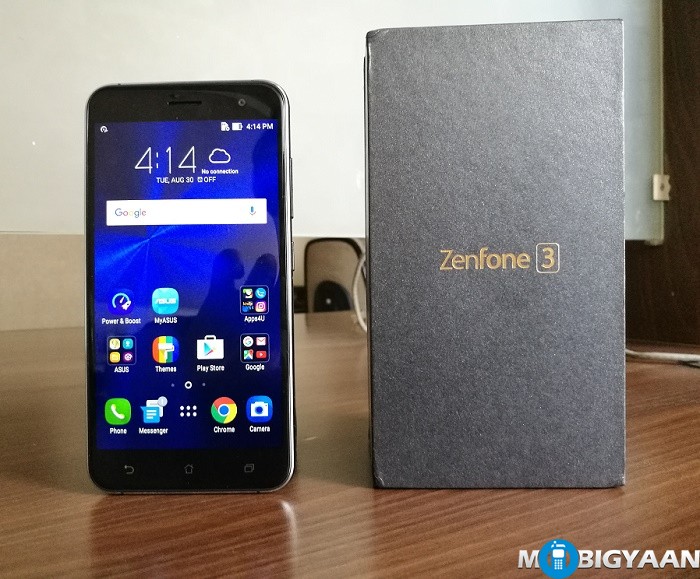
What’s in the Box?
- ASUS ZenFone 3 with built-in battery
- USB Type-C cable
- Power Adapter (5V, 2A)
- Wired Earphones
- User Guide, Warranty Card
- SIM Tray Ejector PIN
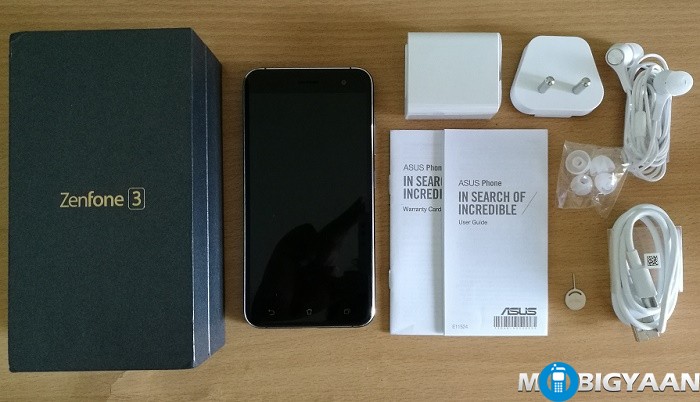
ASUS ZenFone 3 (ZE520KL) Specifications
- Model: ZE520KL
- Display: 5.2-inch Full HD Super IPS+ Display (1920 x 1080 pixels resolution | 424 ppi, 600 nits brightness) protected by 2.5D curved Corning Gorilla Glass 3
- Software: Android 6.0.1 Marshmallow, ASUS ZenUI 3.0
- Fingerprint Scanner: Yes, at the back
- CPU: Up to 2.0 GHz octa-core Cortex-A53 processor, Qualcomm Snapdragon 625 (MSM8953) SoC
- GPU: Adreno 506
- Memory: 3 GB LPDDR3 RAM
- Storage: 32 GB eMCP storage, MicroSD support up to 2 TB, 100 GB Google Drive
- Main Camera: 16 MP (Sony IMX298) sapphire lens protection, 6P Largan Lens, TriTech laser autofocus (0.03s), f/2.0 aperture, 4-axis OIS, EIS support, dual-tone LED flash, 4K Video @30fps
- Front Camera: 8 MP, f/2.0 aperture, 1080p video @30fps
- Connectivity: USB Type-C 1.0, 3.5 mm audio jack, Wi-Fi 802.11 a/b/g/n/ac, Bluetooth 4.2, A-GPS, GLONASS, BDS
- Sensors: Accelerator, E-Compass, Gyroscope, Proximity sensor, Hall sensor, Ambient light sensor, RGB sensor, IR sensor, Fingerprint sensor
- Cellular: 4G LTE support, Hybrid SIM slot – 1x Micro SIM & 1x nano SIM OR MicroSD (GSM + GSM OR GSM + MicroSD)
- Others: SonicMaster 3.0 Audio (24-bit/192kHz), ASUS NoiseZero Talk Technology
- Battery: 2650 mAh (non-removable)
- Power Adapter: Output 5V, 2A
- Dimensions: 146.87 mm x 73.98 mm x 7.69 mm
- Weight: 144 grams
- Colors: Sapphire Black, Moonlight White, Shimmer Gold, Aqua Blue
- Price: ₹21,999
- Warranty: 1 Year Warranty
Design and Build
ASUS ZenFone 3 has got a new look, it’s now covered with Corning Gorilla Glass 3 on both sides. It looks more familiar to the Samsung Galaxy S7. The design changed a lot from its predecessors in terms of design. The plastic body is replaced with metallic frames and scratch-resistant glass shell.
ASUS ZenFone 3 feels premium and expensive when you hold. Its new flashy look features a 2.5D curved glass giving a premium touch. Due to its glass body, it is prone to fingerprints. ASUS ZenFone 3 is a fingerprint magnet. Also, the glass body is highly reflective hence, can be a problem when using outdoors.
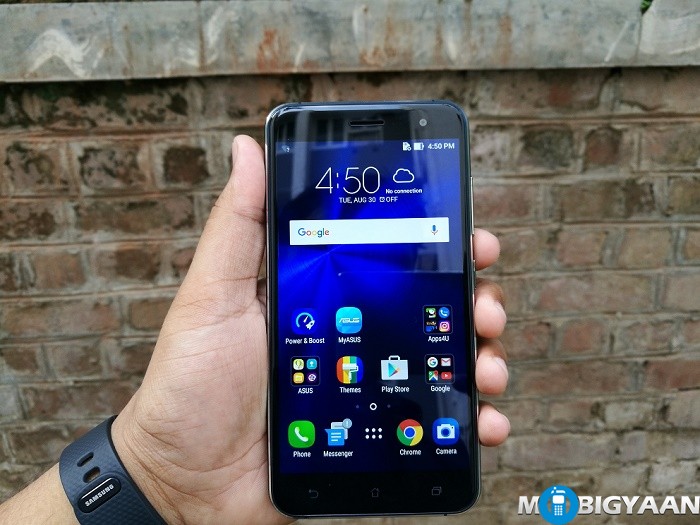
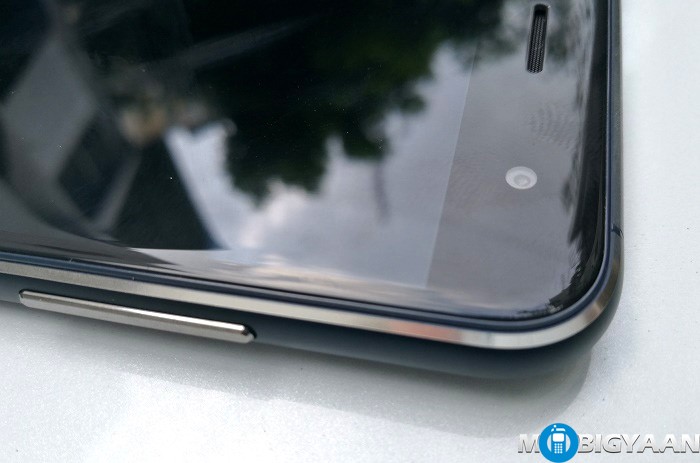
Unlike the older ZenFones, the ZenFone 3 is now slimmer (7.7 mm) and lighter (144 grams). Hence, it is now more comfortable and provides a good grip thanks to its curved 2.5D edges. Its glossy design draws public attention.
On flipping up the phone, you will find a fingerprint scanner which was supposed to be volume buttons. ASUS has replaced the volume buttons with a fast fingerprint scanner.
After all that, the battery has not made an upgrade, in fact, it is degraded to 2650 mAh. The battery cannot be removed. Nowadays many smartphones come with at least 3,000 mAh battery capacity.
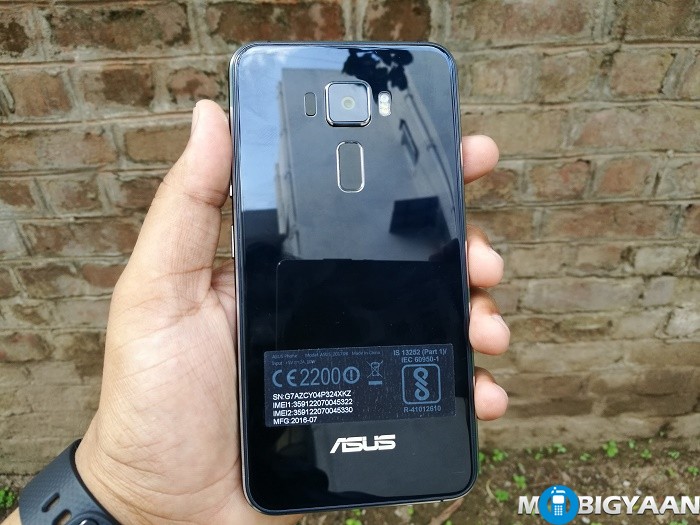
Its companion, ZenFone 3 Deluxe comes with a Super AMOLED display. It would be better if ASUS could use an AMOLED display in the ZenFone 3 but instead you get a Super IPS+ display which sounds pretty reasonable for its price.
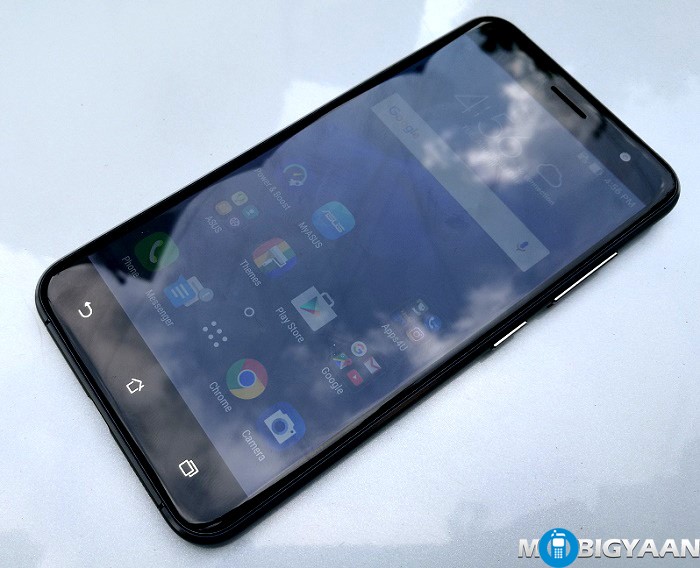
ASUS ZenFone 3 packs a punch with its camera. It uses a 16 MP (Sony IMX298) f/2.0 TriTech laser autofocus camera with dual-tone LED flash. The camera lens is protected by a sapphire glass. It further supports 4-axis optical image stabilization and electronic image stabilization. You can record 4K videos with its 16 MP camera. As for the front end, there is an 8 MP f/2.0 camera.
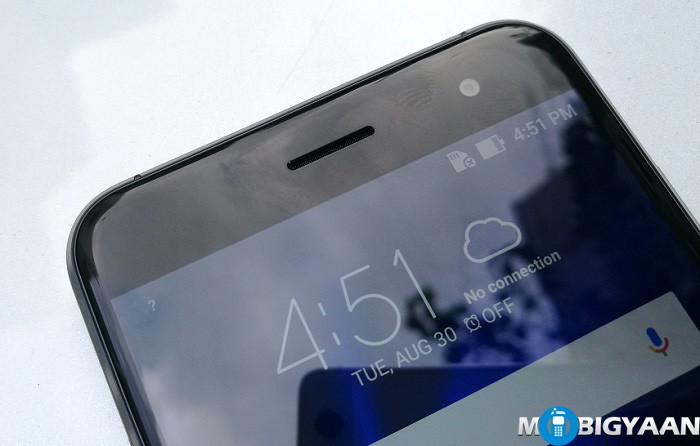
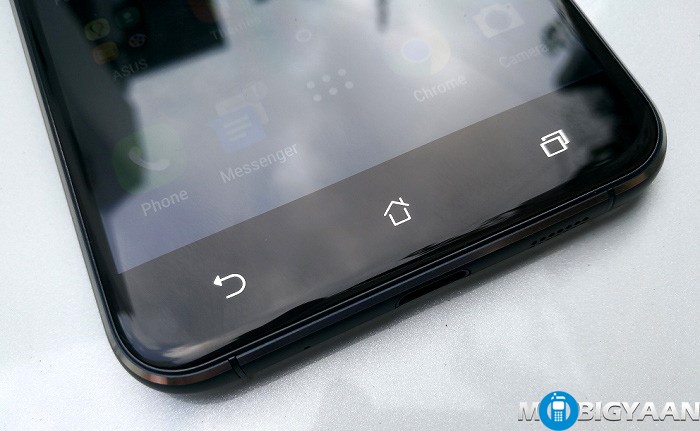
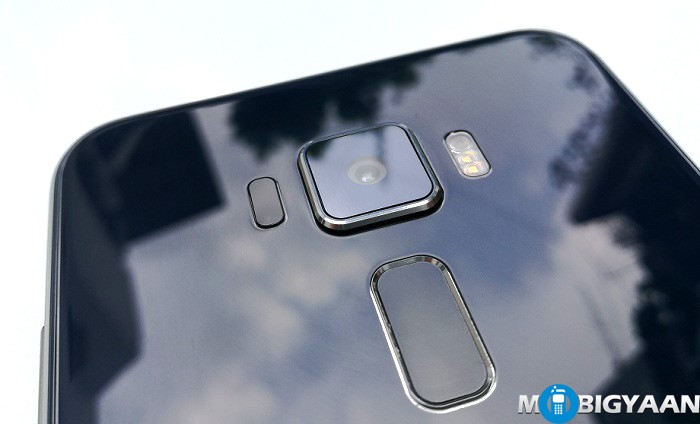
The metallic frame feels very good. The right side has the power and volume buttons. The Hybrid SIM tray on the left holds 2 SIM slots. SIM1 slot holds a Micro SIM card while SIM2 slot holds a Nano SIM card. The SIM2 slot can be replaced with a MicroSD card up to 2 TB. ASUS ZenFone 3 supports 4G network and it’s VoLTE-enabled.
On the top, you will find a 3.5 mm stereo port and a microphone. On the bottom, there is a USB Type-C port, a microphone and loudspeakers grill.
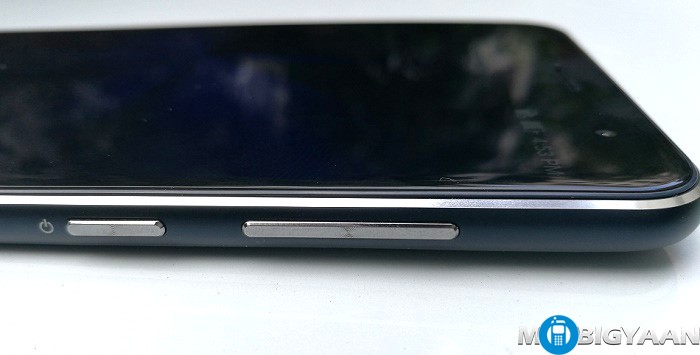
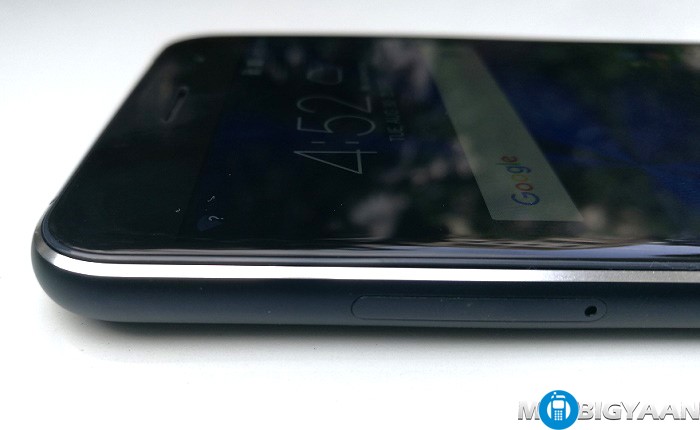
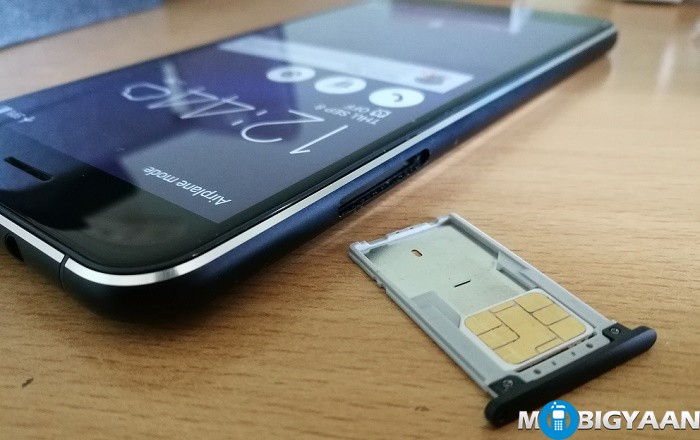
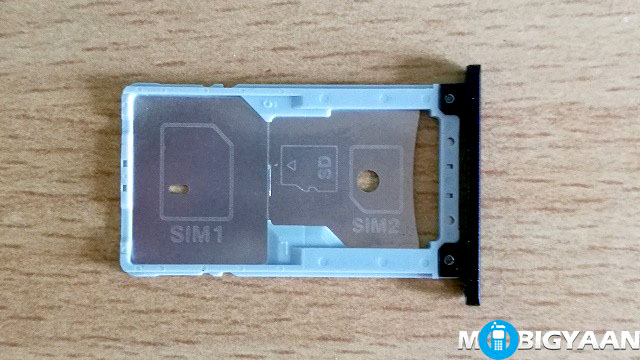
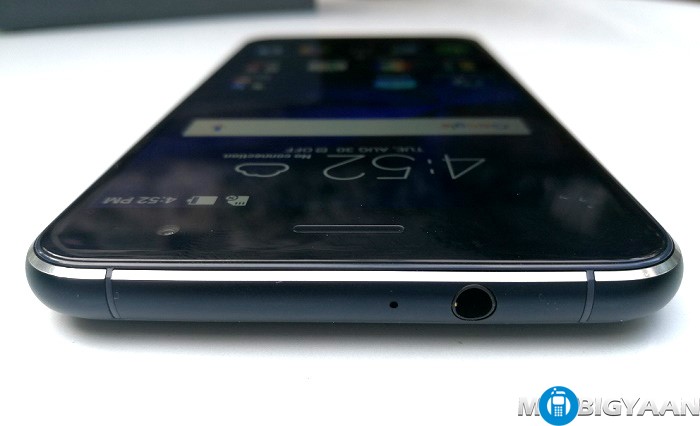
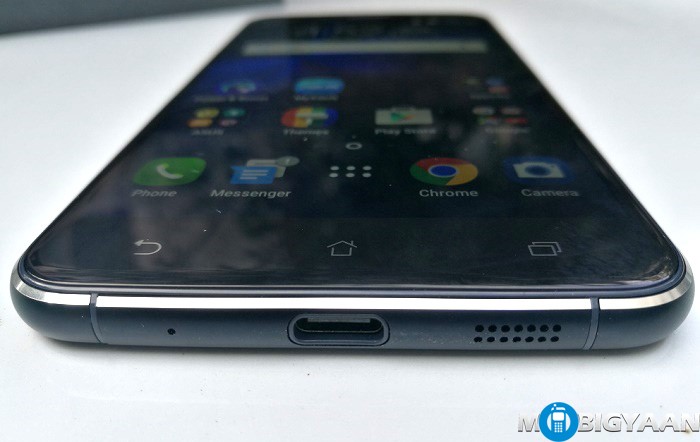
Display
ASUS ZenFone boasts a 5.2-inch Full HD Super IPS+ Display with a resolution of 1920 x 1080 pixels resolution (424 ppi) and 600 nits brightness. The display is protected by a 2.5D curved Corning Gorilla Glass 3 on both sides. This makes the phone slippery and prone to fingerprints. Due to the reflective glass, sometimes you may not be able to read the screen in a bright daylight but, you can view it under the shades. Otherwise, has very good viewing angles.
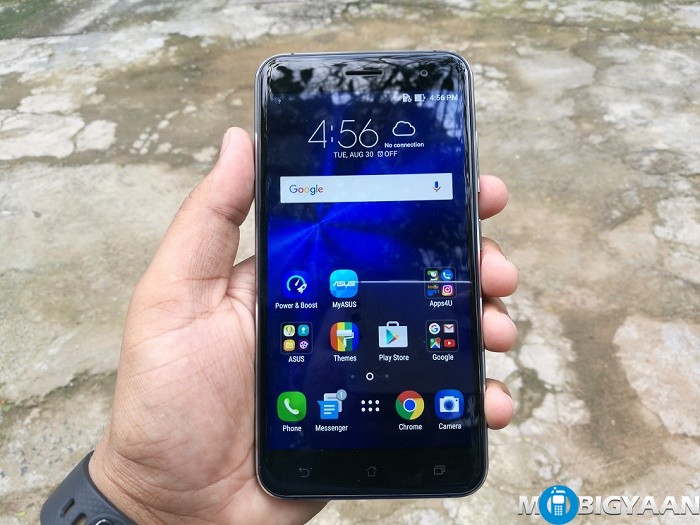
Software and User Interface
ZenUI 3.0 is the new interface from ASUS based on Android 6.0.1 Marshmallow. What’s new in the ZenUI 3.0 is a brand new look, enhanced wallpaper settings, and motion wallpaper effect. It also comes with a Mobile Manager that you’ve seen in the ZenUI 2.0 that lets you keep track of and manage stuff like data usage, battery saving, performance boost, notification management, storage cleanup, privacy and security, and app permissions.
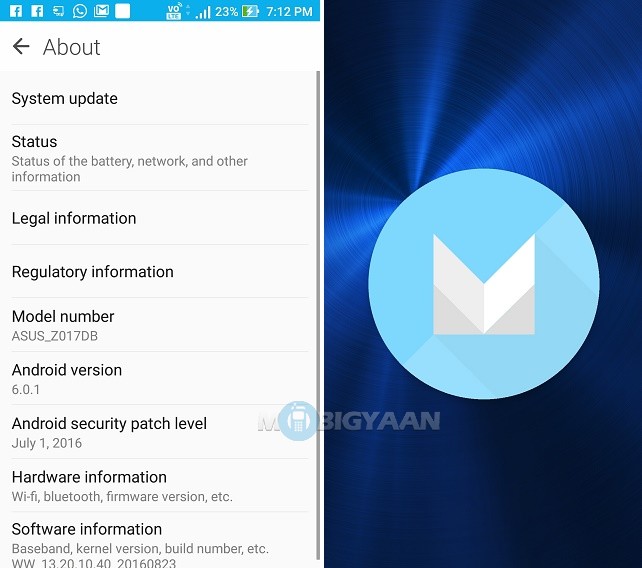
The interface remains smooth and light but what bugs me here is the amount of bloatware it has. ASUS once again provided bloatware. The ZenUI 3.0 can be used to customize the interface as per needs. The rest of the stuff we have already explained in our previous ZenFone reviews. Do check them out.
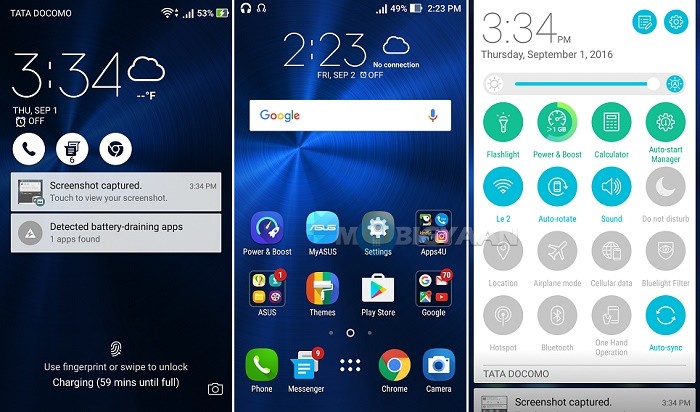
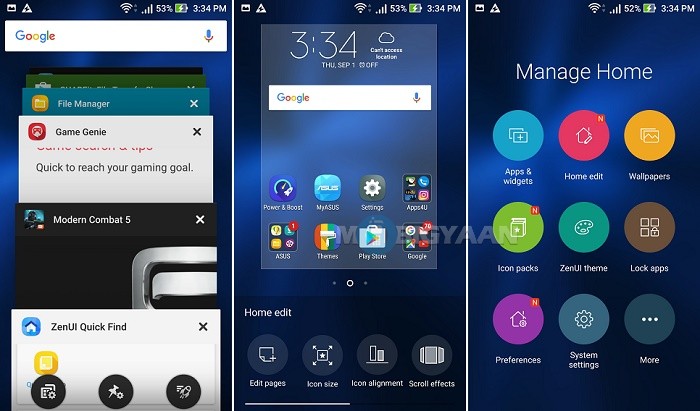
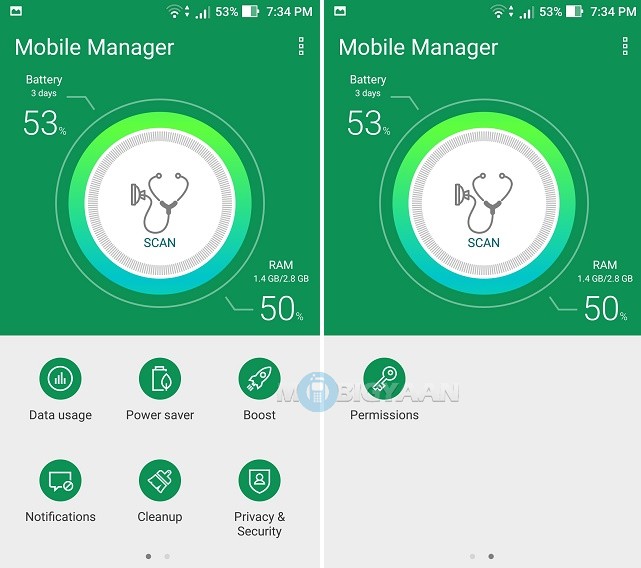
Fingerprint Scanner
ASUS ZenFone 3 now comes with a fingerprint scanner which was actually missing in all the other previous ZenFones. It is located on the back below the camera.

One of the best fingerprint scanners I have seen. It is super fast and I doubt it is as fast as the fingerprint scanner I have seen in the Huawei P9.
The fingerprint scanner takes 12 finger taps to add a fingerprint. It recognizes your fingerprint in 360 degrees in any direction. You can add a maximum of 5 fingerprints at a time. The fingerprint scanner doesn’t work with wet fingers.
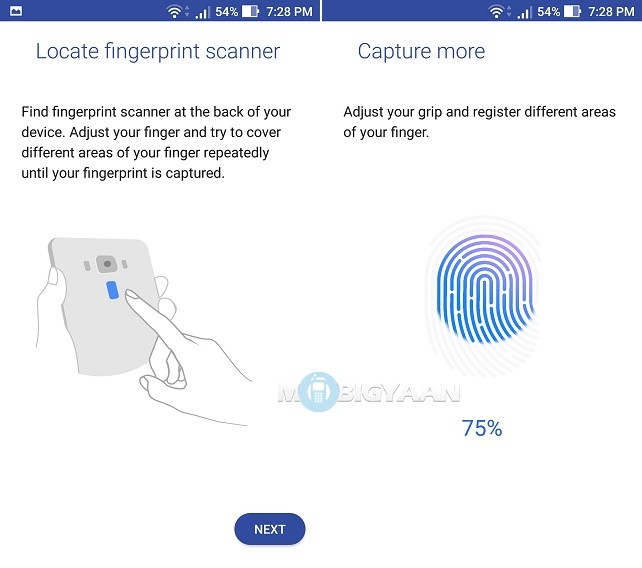
Hardware, Performance and Gaming
ZenFone 3 equips the newly launched Qualcomm Snapdragon 625 SoC and with that, ZenFone 3 becomes the first smartphone in the world to house a Qualcomm Snapdragon 625 SoC.
The SoC has eight power-efficient Cortex-A53 cores that can go up to 2.0 GHz. It is manufactured in a 14 nm FinFET fabrication tech and integrates an X9 LTE modem for 4G connectivity. Moreover, ZenFone 3 has got a 3 GB LPDDR3 RAM and an Adreno 506 GPU. It’s onboard 32 GB eMCP storage can be expanded using a MicroSD card.
Zenfone 3 can be used as a daily driver with this Snapdragon 625, the performance is quite decent. We found the performance good in day-to-day tasks with no lags. Sometimes ZenUI 3.0 can be the culprit because the skin is tad heavy and takes ample amount of hardware resources. The free RAM you get is around 1.4 GB in most cases but can be reduced to 1 GB if you use the phone for multitasking. Nevertheless, ZenUI 3.0 also provides a RAM cleaner to free up the RAM.
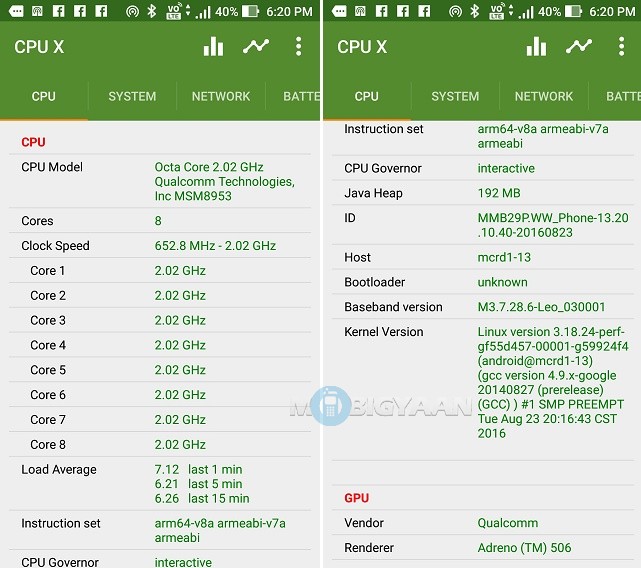
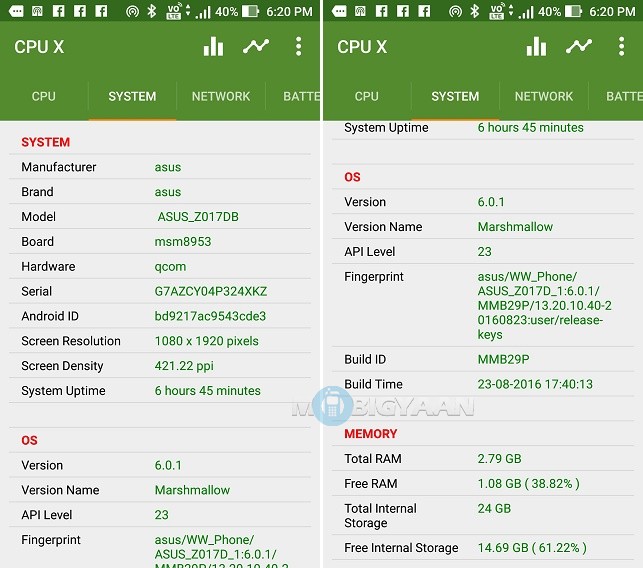
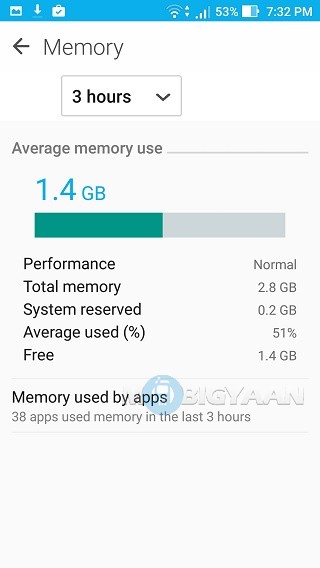
AnTuTu benchmark gave us very good results, the overall score for AnTuTu we got was 61,770 points. The score is still behind the cheaper Chinese alternatives like Xiaomi Redmi Note 3 and LeEco Le 2 having Snapdragon 650 and Snapdragon 652 CPU. Although, the score is still better than the smartphones incorporating a Snapdragon 617 like the Coolpad Max.
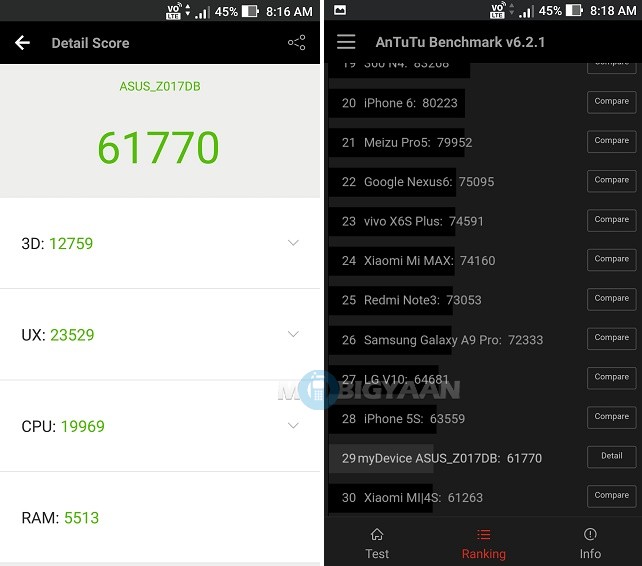
We benchmarked on the newest Geekbench 4 and here are the results. For single core, it’s 814 points and for multi-core, it’s 3,944 points. The score is close to the Kirin 650 CPU found in Honor 5C while still behind the Snapdragon 650 and 652 based smartphones.
Not just that, the new Geekbench 4 has benchmarking for GPU as well. The score is 2,451 for its Adreno 506.
Here are the full benchmark results of Geekbench 4:
The Quadrant Standard Edition scored 40,353 points.
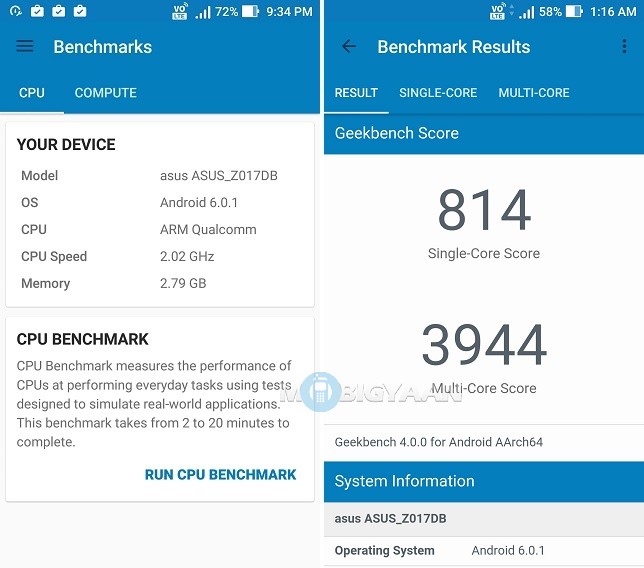
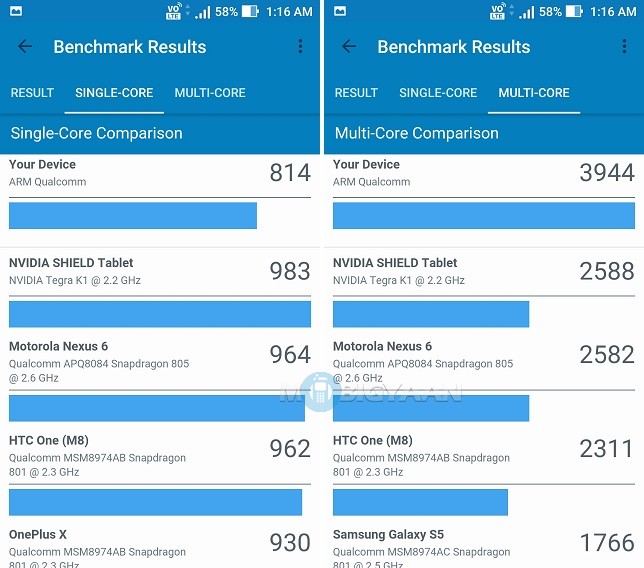
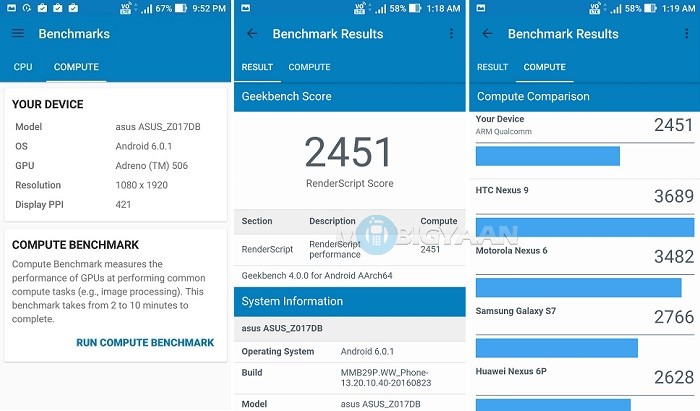
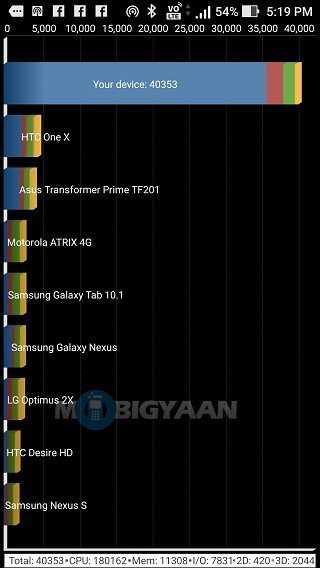
Coming to its gaming performance, We haven’t faced any lagging or stuttering on a regular use. Gaming on ZenFone 3 was quite decent, we ran games like Angry Birds 2, Asphalt 8: Airborne, Modern Combat 5, Shadow Fight 2. Due to its LPDDR3, the loading times may let you wait for a while to load intensive games. Some graphics hungry games may struggle for its entry level GPU.
A similar trait to Samsung Galaxy S7, the ZenUI 3.0 offers a software that records your live gameplay and broadcasts to YouTube and Twitch. Recording the games will drop the framerates significantly.
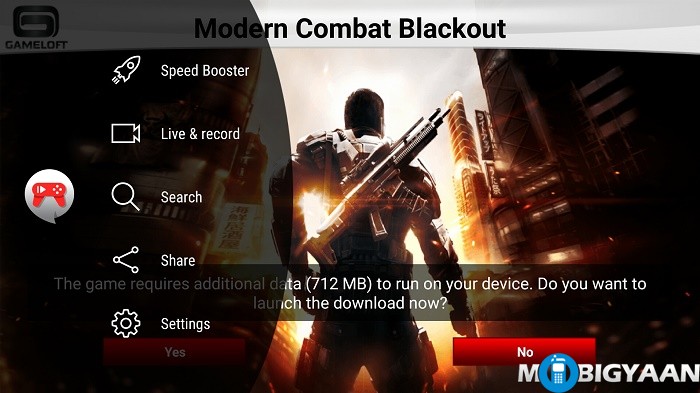


Games Tested on ASUS ZenFone 3:
- Angry Birds 2
- Asphalt 8: Airborne
- Modern Combat 5
- Shadow Fight 2


The handset remains cool while playing games, though it gets warm but doesn’t pick high heat. It also gets warm when using the camera.
Storage and Connectivity
For the storage, ZenFone 3 comes with 32 GB internal storage from which you get 24 GB of free space, the remaining 8 GB is reserved for the system. The good thing is it supports a MicroSD card. A 64 GB ZenFone 3 variant is also available with 4 GB RAM and higher battery capacity (3000 mAH).
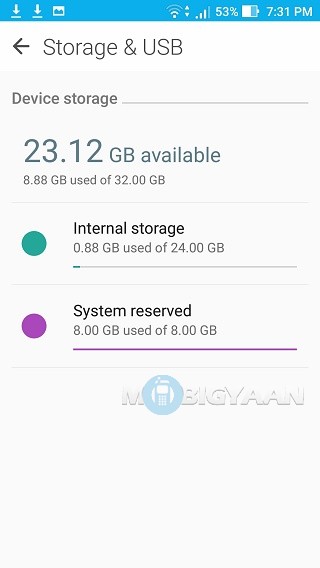
The storage benchmark we got for ASUS ZenFone 3 using A1 SD Bench and AndroBench are as follows. The read and write speed we got on AndroBench were 268.83 MB/s and 138.86 MB/s both sequential. The random read and write were at 74.15 MB/s and 10.48 MB/s. On A1 SD Bench, we got 236.13 MB/s read speed and 148.12 MB/s write speed. It uses a Samsung eMCP memory chip for its internal storage. The storage performance wasn’t really surprising as we saw in the OnePlus 3, so not the best out there. However, it is still better than many smartphones such as Sony Xperia Z5 Dual.
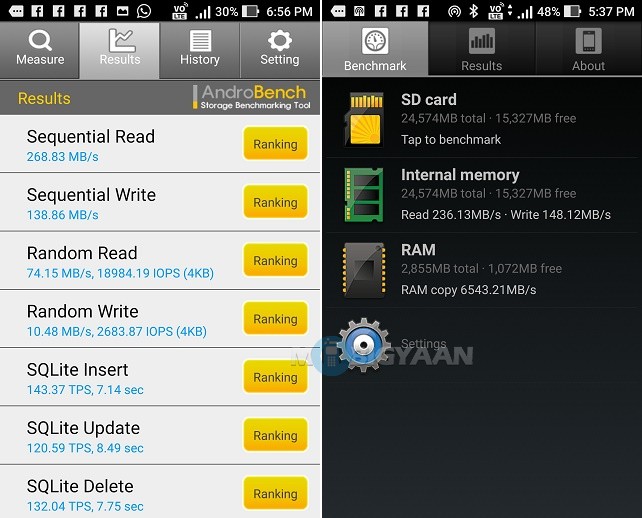
ZenFone 3 now uses a new USB Type-C port. The type-C port is reversible and can be connected either side to the phone.
Cameras
ASUS Zenfone 3 has brought us an amazing camera experience. Its 16 MP camera is top notch along with tons of camera features. The camera uses a Sony IMX298 sensor found in flagships like OnePlus 3 and Xiaomi Mi 5. The camera supports OIS and EIS.
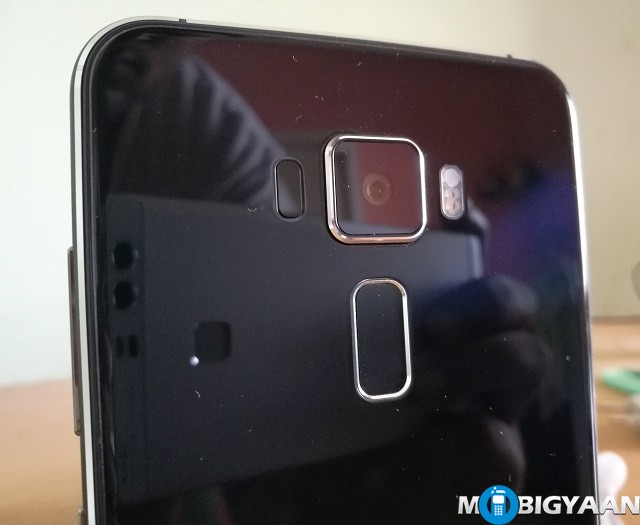
ASUS Zenfone 3 Camera Specifications (ZE520KL)
- Camera: 16 MP, f/2.0, TriTech laser autofocus (0.03s)
- Sensor: Sony Exmor IMX298
- Lens Protection: Sapphire Glass
- Optical Image Stabilization (OIS): Yes, 4-axis
- Electronic Image Stabilization (EIS): Yes
- Rear Flash: Dual LED Flash
- Features: Geo-tagging, Tap to Focus, Pro HDR, Manual, Beautification, Panorama, Slow Motion, Time Lapse, Burst Shot, Super Resolution, Low Light, Night, Depth of Field, GIF Animation, QR Code, Time Rewind, All Smiles, Smart Remove, Children, Selfie, Effect, Miniature
- Video Recording: Up to 4K video recording, 2160p@30 FPS, Slow Motion 720p@120 FPS, HDR Support
- Front Camera: 8 MP, f/2.0, wide angle lens
- Video Recording: Up to 1080p @30fps
- Front Flash: No
The camera module on ZenFone 3 is upgraded extensively. Old ZenFone 2 was using a 13 MP snapper. The camera software uses new Pixel Master 3.0 tech giving a complete experience of a digital camera. It also comes with Tritech laser focus for capturing sharp images.
The camera supports various modes like HDR, Panorama, Manual, Beautification, Super Resolution, Low Light, Night, Depth of Field, GIF Animation, QR Code, Time Rewind, All Smiles, Smart Remove, Slow Motion, Time Lapse, and much more.
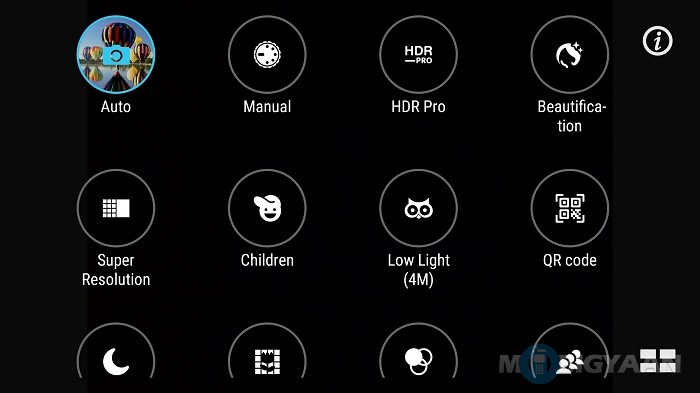
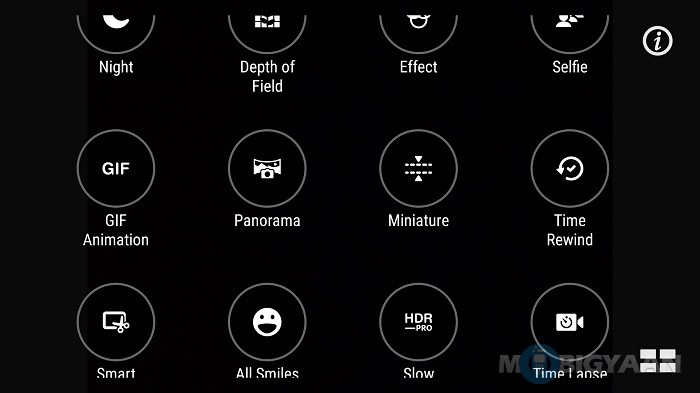
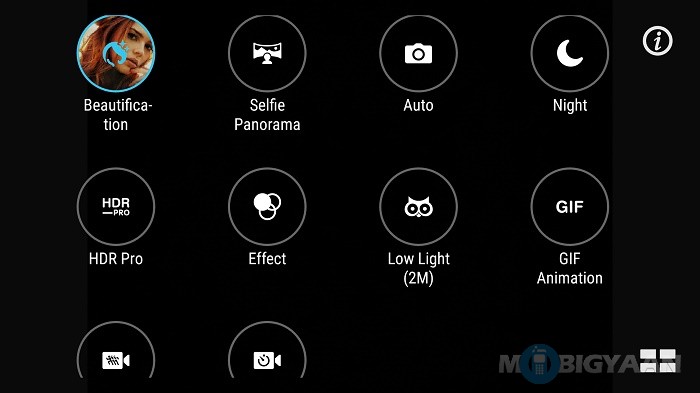
ASUS Zenfone 3 Camera Samples
The best thing in ZenFone after its design is its camera. The camera results in detailed and very sharp images, no grainy images but crisp and clear in daylight. HDR shots turn out to be good but at some point, the camera sometimes captures overexposed HDR images in a wild sunny day. Nevertheless, camera enthusiast will be thrilled with its Manual mode.
Another impressive thing about the camera is the Low light performance, it is fairly strong in my opinion, though you need a Tripod to capture a perfect night shot. The rear camera can capture 4K videos, thanks to the OIS support. The camera interface offers much more than an average smartphone camera. The front 8 MP camera is not the best out there but among the decent performers. Overall, the camera package is as good as OnePlus 3 camera.
Battery
ASUS ZenFone 3 boasts a 2,650 mAh battery and that seems a weak battery or you can say average. However, we found out that the battery runtime is high in this regards. The 2,650 mAh gave very some good results which were beyond my expectations. The battery life is above average and gets you throughout the day when used frequently. While the moderate usage results are great, it runs a day and a half when used occasionally. It hardly draws any battery power when in a locked state. Please note that, prolong usage of the phone will drain the battery faster such as playing games for long hours. We used the phone with a continuous 4G connection.
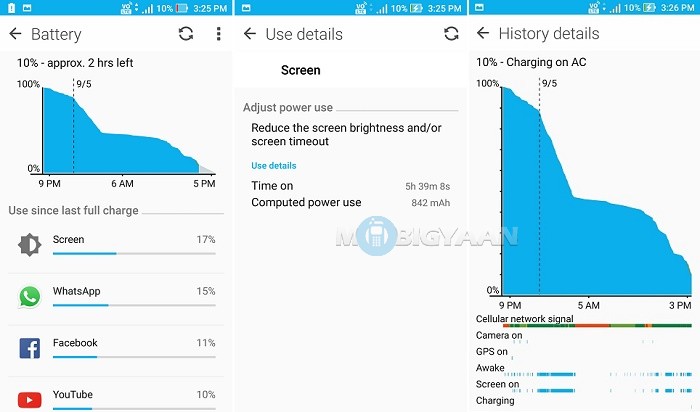
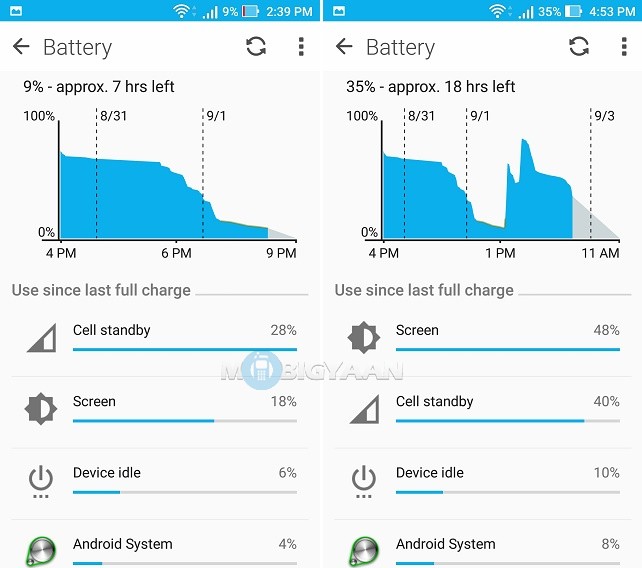
ZenUI 3.0 comes with a Mobile Manager app that lets you manage the settings to increase the battery life. There are 4 battery modes – Performance, Normal, Power saving, and Super saving. Upon choosing the desired power saving option can get you ample of battery life.
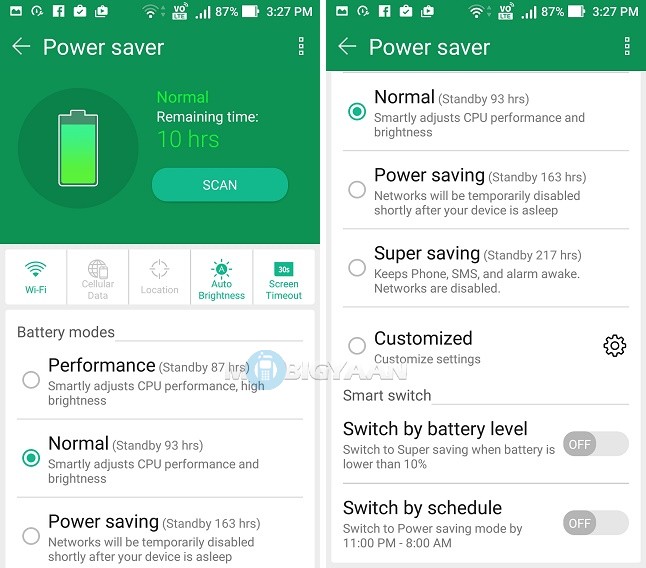
I believe if ZenFone 3 have used an AMOLED display, there would be a slight difference in the battery life, the results can be surprising. What’s even more surprising is if the ZenFone 3 could sport 3000 mAh like the others out there. Nevertheless, The battery runtime is very much satisfying as compared to other smartphones in the price range.
The table below shows you how much battery apps and games installed consume approximately in our test.
[table id=56 responsive=flip /]
Pricing and Variants
ASUS ZenFone 3 is priced at ₹21,999. There are total four variants:
- ASUS ZenFone 3 (Sapphire Black)
- ASUS ZenFone 3 (Moonlight White)
- ASUS ZenFone 3 (Shimmer Gold)
- ASUS ZenFone 3 (Aqua Blue)
Verdict – Worth Buy?
If we talk about the design and its camera, then we think ASUS ZenFone 3 could be deserving, its looks are appealing, the camera is performing flawlessly. More to it, the battery runtime is somewhat better than average. ZenFone 3 offers 32 GB onboard storage along with 100 GB of Google Drive storage. It has such an odd pricing in a sub ₹20,000 bracket but it seems to be underpowered as the CPU performance matches to a ₹10,999 Honor 5C. Also, there are a few Chinese smartphones performing way better than ZenFone 3 in similar price in terms of CPU performance.
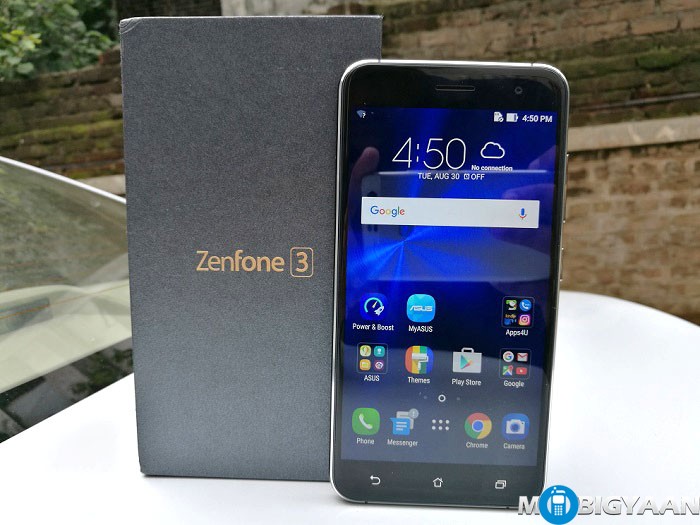
So should you buy it? The ASUS ZenFone 3 is available at ₹21,999. If you don’t run high intensive tasks and games, but want a beautiful looking smartphone with a great camera, it’s a yes. A great advantage for all the ZenFones is they are available in offline stores too. Furthermore, it also bundles earphones while many others don’t. But, if you want to run graphics intensive games and heavy applications that require more CPU power, we would suggest you look at the other similar priced smartphones before you buy ZenFone 3.
Competitors:
- LeEco Le Max 2 – ₹22,999
- Xiaomi Mi 5 – ₹22,999
Strength
- Beautiful Glossy Design
- Slim and Lightweight
- Excellent Camera Performance
- Super Fast Fingerprint Scanner
- Above Average Battery Life
- MicroSD card support
- 100 GB Google Drive Free
Weakness
- Bloatware
- No backlit touch buttons
- Slippery


